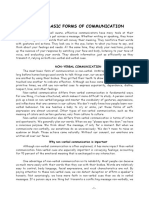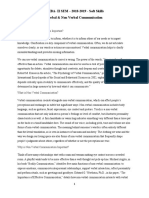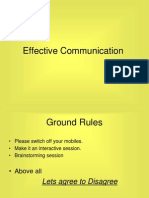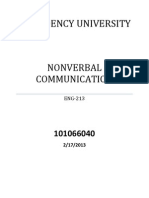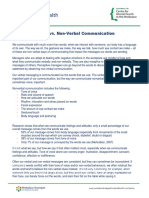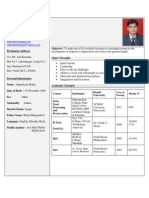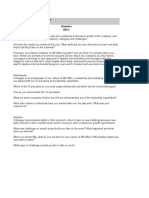Business Communication Assignment
Submitted to:- Dr. A.K.Rajpal
Submitted by:Sahil Ahuja MBA (G), 2013 C-49 A0101911248 DATE: - 16-08-2012
�Non Verbal Communication In Every Day Life
Question. Discuss the situation in the light of Non Verbal Advantage in every day encounters within the organization and also your opinion as to what non verbal cues that you would sport to avoid being delayed in various such relevant situations you ever found yourself placed or may find yourself placed?
Answer.
Nonverbal communication, or body language, is a vital form of communicationa natural, unconscious language that broadcasts our true feelings and intentions in any given moment, and clues us in to the feelings and intentions of those around us. When we interact with others, we continuously give and receive wordless signals. All of our nonverbal behaviorsthe gestures we make, the way we sit, how fast or how loud we talk, how close we stand, how much eye contact we makesend strong messages. These messages dont stop when you stop speaking either. Even when youre silent, youre still communicating nonverbally.
�Oftentimes, what we say and what we communicate through body language are two totally different things. When faced with these mixed signals, the listener has to choose whether to believe your verbal or nonverbal message, and, in most cases, theyre going to choose nonverbal. The way you listen, look, move, and react tells the other person whether or not you care, if youre being truthful, and how well youre listening. When your nonverbal signals match up with the words youre saying, they increase trust, clarity, and rapport. When they dont, they generate tension, mistrust, and confusion. If you want to communicate better in all areas of your life, its important to become more sensitive to body language and other nonverbal cues, so you can be more in tune with the thoughts and feelings of others. You also need to be aware of the signals youre sending off, so you can be sure that the messages youre sending are what you really want to communication
TYPES OF NON VERBAL COMMUNICATION
There are many different types of nonverbal communication. Together, the following nonverbal signals and cues communicate your interest and investment in others. FACIAL EXPRESSION The human face is extremely expressive, able to express countless emotions without saying a word. And unlike some forms of nonverbal communication, facial expressions are universal. The facial expressions for happiness, sadness, anger, surprise, fear, and disgust are the same across cultures. BODY MOVEMENT AND POSTURE Consider how your perceptions of people are affected by the way they sit, walk, stand up, or hold their head. The way you move and carry yourself communicates a wealth of information to the world. This type of nonverbal communication includes your posture, bearing, stance, and subtle movements.
�GESTURES Gestures are woven into the fabric of our daily lives. We wave, point, beckon, and use our hands when were arguing or speaking animatedlyexpressing ourselves with gestures often without thinking. However, the meaning of gestures can be very different across cultures and regions, so its important to be careful to avoid misinterpretation. EYE CONTACT Since the visual sense is dominant for most people, eye contact is an especially important type of nonverbal communication. The way you look at someone can communicate many things, including interest, affection, hostility, or attraction. Eye contact is also important in maintaining the flow of conversation and for gauging the other persons response. TOUCH We communicate a great deal through touch. Think about the messages given by the following: a firm handshake, a timid tap on the shoulder, a warm bear hug, a reassuring pat on the back, a patronizing pat on the head, or a controlling grip on your arm. SPACE Have you ever felt uncomfortable during a conversation because the other person was standing too close and invading your space? We all have a need for physical space, although that need differs depending on the culture, the situation, and the closeness of the relationship. You can use physical space to communicate many different nonverbal messages, including signals of intimacy, aggression, dominance, or affection. VOICE Its not just what you say, its how you say it. When we speak, other people read our voices in addition to listening to our words. Things they pay attention to include your timing and pace, how loud you speak, your tone and inflection, and sounds that convey understanding, such as ahh and uh-huh. Think about how tone of voice, for example, can indicate sarcasm, anger, affection, or confidence.
�CASE DISCUSSION
A recent study of 400 drivers in a shopping mall found that drivers took longer to pull out of a space if someone was waiting for them than if nobody was there to claim the space. On average, if nobody was waiting for the space, drivers took 32.2 seconds to pull out of a spot after opening a car door. If someone was waiting, drivers took about 39 seconds. And woe to the person who honks to hurry a driver: Drivers took 43 seconds to pull out of a space when the waiting driver honked, in this kind of situation a smiling face could motivate the driver to pull out the car fast or a simple dipper could initiate a silent interaction between both the drivers. 1. Similarly interaction with clients, the key to good nonverbal communication is observing what the client needs and wants, it is important to remember that, Politeness and friendliness are key behaviors in a business interaction. It is the businesspersons job to pick up on nonverbal cues and facial expressions, or note when a client is increasing physical distance or using blocking gestures, she adds. Clients are satisfied when you can perceive what they want by their unsaid communication, such as posture, tone of voice, voice speed or body position. 2. An employee may conclude that a new worker doesnt like him because that person doesnt make eye contact or keeps a physical distance. But the person could be shy or introverted and may have been interpreted incorrectly. It is important to remember that it takes two people to communicate: one to express and the other to perceive.
